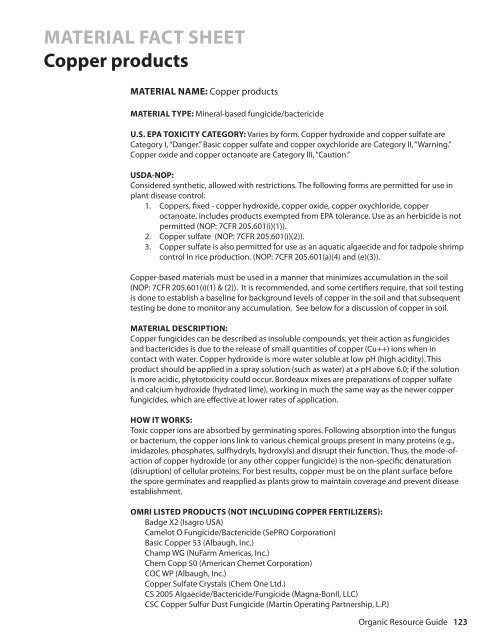Resource Guide for Organic Insect and Disease ... - Cornell University
Resource Guide for Organic Insect and Disease ... - Cornell University
Resource Guide for Organic Insect and Disease ... - Cornell University
Create successful ePaper yourself
Turn your PDF publications into a flip-book with our unique Google optimized e-Paper software.
MATERIAL FACT SHEET<br />
Copper products<br />
MATERIAL NAME: Copper products<br />
MATERIAL TYPE: Mineral-based fungicide/bactericide<br />
U.S. EPA TOXICITY CATEGORY: Varies by <strong>for</strong>m. Copper hydroxide <strong>and</strong> copper sulfate are<br />
Category I, “Danger.” Basic copper sulfate <strong>and</strong> copper oxychloride are Category II, “Warning.”<br />
Copper oxide <strong>and</strong> copper octanoate are Category III, “Caution.”<br />
USDA-NOP:<br />
Considered synthetic, allowed with restrictions. The following <strong>for</strong>ms are permitted <strong>for</strong> use in<br />
plant disease control:<br />
1. Coppers, fixed - copper hydroxide, copper oxide, copper oxychloride, copper<br />
octanoate, includes products exempted from EPA tolerance. Use as an herbicide is not<br />
permitted (NOP: 7CFR 205.601(i)(1)).<br />
2. Copper sulfate (NOP: 7CFR 205.601(i)(2)).<br />
3. Copper sulfate is also permitted <strong>for</strong> use as an aquatic algaecide <strong>and</strong> <strong>for</strong> tadpole shrimp<br />
control in rice production. (NOP: 7CFR 205.601(a)(4) <strong>and</strong> (e)(3)).<br />
Copper-based materials must be used in a manner that minimizes accumulation in the soil<br />
(NOP: 7CFR 205.601(i)(1) & (2)). It is recommended, <strong>and</strong> some certifiers require, that soil testing<br />
is done to establish a baseline <strong>for</strong> background levels of copper in the soil <strong>and</strong> that subsequent<br />
testing be done to monitor any accumulation. See below <strong>for</strong> a discussion of copper in soil.<br />
MATERIAL DESCRIPTION:<br />
Copper fungicides can be described as insoluble compounds, yet their action as fungicides<br />
<strong>and</strong> bactericides is due to the release of small quantities of copper (Cu++) ions when in<br />
contact with water. Copper hydroxide is more water soluble at low pH (high acidity). This<br />
product should be applied in a spray solution (such as water) at a pH above 6.0; if the solution<br />
is more acidic, phytotoxicity could occur. Bordeaux mixes are preparations of copper sulfate<br />
<strong>and</strong> calcium hydroxide (hydrated lime), working in much the same way as the newer copper<br />
fungicides, which are effective at lower rates of application.<br />
HOW IT WORKS:<br />
Toxic copper ions are absorbed by germinating spores. Following absorption into the fungus<br />
or bacterium, the copper ions link to various chemical groups present in many proteins (e.g.,<br />
imidazoles, phosphates, sulfhydryls, hydroxyls) <strong>and</strong> disrupt their function. Thus, the mode-ofaction<br />
of copper hydroxide (or any other copper fungicide) is the non-specific denaturation<br />
(disruption) of cellular proteins. For best results, copper must be on the plant surface be<strong>for</strong>e<br />
the spore germinates <strong>and</strong> reapplied as plants grow to maintain coverage <strong>and</strong> prevent disease<br />
establishment.<br />
OMRI LISTED PRODUCTS (NOT INCLUDING COPPER FERTILIZERS):<br />
Badge X2 (Isagro USA)<br />
Camelot O Fungicide/Bactericide (SePRO Corporation)<br />
Basic Copper 53 (Albaugh, Inc.)<br />
Champ WG (NuFarm Americas, Inc.)<br />
Chem Copp 50 (American Chemet Corporation)<br />
COC WP (Albaugh, Inc.)<br />
Copper Sulfate Crystals (Chem One Ltd.)<br />
CS 2005 Algaecide/Bactericide/Fungicide (Magna-BonII, LLC)<br />
CSC Copper Sulfur Dust Fungicide (Martin Operating Partnership, L.P.)<br />
<strong>Organic</strong> <strong>Resource</strong> <strong>Guide</strong> 123







